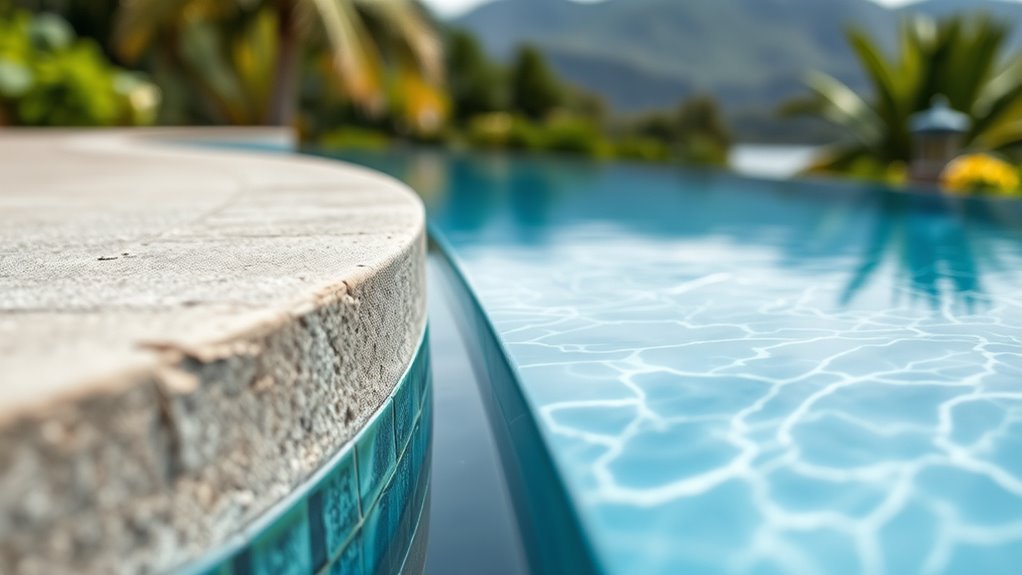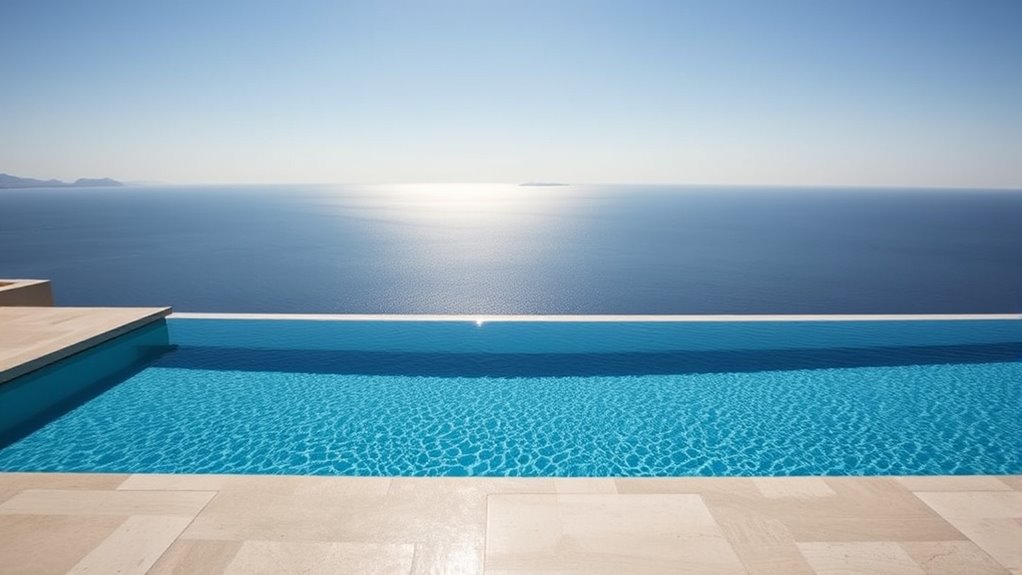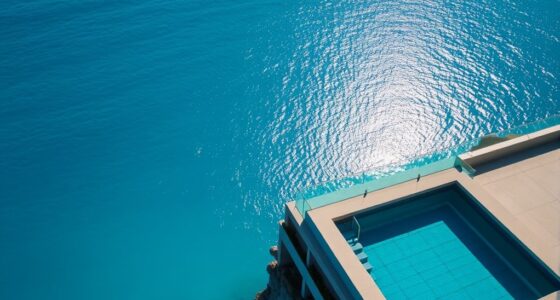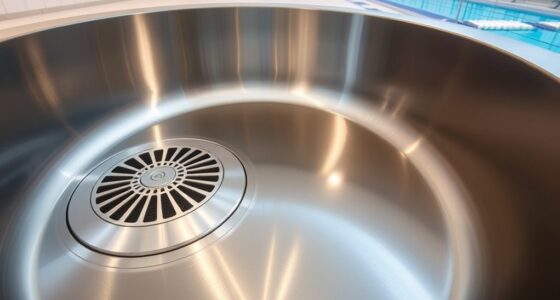When choosing between concrete and fiberglass shells for your infinity pool, consider durability, design flexibility, and costs. Concrete offers superior strength, customizable shapes, and unique finishes but takes longer to install and costs more upfront. Fiberglass provides a faster, more streamlined installation, with glossy surfaces that reflect light beautifully. Each option impacts your pool’s look and long-term maintenance. Keep exploring further to discover which material best suits your style and budget.
Key Takeaways
- Concrete shells offer greater design flexibility for custom shapes and features compared to pre-molded fiberglass shells.
- Fiberglass shells provide quick installation with smooth, reflective surfaces, while concrete requires longer curing and construction time.
- Concrete pools can be personalized with textured, tiled, or stained finishes, enhancing aesthetic options for infinity pools.
- Fiberglass pools have limited surface finish choices but deliver vibrant, glossy appearances that reflect light effectively.
- Cost and durability vary; concrete is more customizable and long-lasting, whereas fiberglass offers faster installation and lower maintenance.
Durability and Structural Integrity

When it comes to durability and structural integrity, concrete shells are known for their exceptional strength and long-lasting performance. You can count on them to withstand heavy loads, harsh weather, and ground shifts without cracking or deteriorating. Concrete’s dense composition provides a solid foundation that resists impact and pressure, making it ideal for large, permanent pools. Its ability to be reinforced with steel further enhances its stability, ensuring the shell maintains its shape over decades. Unlike other materials, concrete resists water penetration and corrosion, reducing the risk of structural failure. This robustness means you won’t have to worry about frequent repairs or replacements, giving you peace of mind that your pool will remain secure and functional for years to come. Additionally, proper construction techniques play a vital role in maximizing the longevity and performance of concrete shells.
Customization and Design Flexibility

Concrete shells offer a high degree of customization and design flexibility, allowing you to create pools tailored precisely to your preferences. With concrete, you can choose virtually any shape, size, or depth, ensuring your pool complements your landscape and style. You can add unique features like waterfalls, built-in seating, or custom lighting to enhance your pool’s appeal. Here are three ways concrete provides unmatched flexibility:
Concrete pools are highly customizable, offering endless options for shapes, features, and finishes to match your style.
- Shape and Layout: Design complex, freeform, or geometric pools that fit your space perfectly.
- Surface Texture: Opt for smooth finishes or textured surfaces for aesthetic and functional purposes.
- Additional Features: Incorporate custom features like spa areas, tanning ledges, or integrated steps seamlessly. Concrete allows for design versatility, enabling you to realize even the most intricate ideas for your infinity pool.
Installation Process and Timeframe

The installation process of a concrete shell pool typically takes longer and involves more steps compared to other options. First, you’ll need to excavate the site and build a sturdy framework to support the concrete. Once the forms are in place, the concrete is poured and requires several days to cure properly. After curing, the shell is waterproofed, and plumbing fixtures are installed. This process can take several weeks, depending on the size and complexity of your design. The longer timeframe allows for customization options, but means your project will span over multiple phases. Overall, concrete pools demand patience, as each step must be completed meticulously to ensure durability and quality.
Cost Considerations and Budgeting

Budgeting for a concrete shell pool requires careful planning, as it generally involves higher upfront costs compared to other pool types. The initial investment includes excavation, formwork, reinforcement, and finishing, which can add up quickly. Here are three key cost factors to consider:
- Construction Expenses: Concrete pools typically cost between $50,000 and $100,000, depending on size and design complexity.
- Permits and Site Prep: Permitting fees, excavation, and site preparation can add several thousand dollars to your budget.
- Customization and Features: Specialty finishes, waterfalls, lighting, and other add-ons increase overall costs.
Being aware of these factors helps you allocate funds effectively and avoid surprises during the project. Proper budgeting ensures your dream infinity pool fits your financial plan. Additionally, understanding market trends can help you make informed decisions about features and upgrades within your budget.
Maintenance and Long-Term Care

Maintaining a concrete shell pool requires regular inspections, cleaning, and repairs to keep it in ideal condition over time. You’ll need to check for cracks, chips, and surface wear periodically. Cleaning involves skimming debris, vacuuming, and balancing chemicals to prevent algae growth. Repairs may be necessary to address cracks or surface deterioration, which can be costly. Additionally, understanding the shelf life of pool materials can help plan timely maintenance and replacements.
Aesthetic Appeal and Finishing Options

When it comes to aesthetic appeal, both concrete and fiberglass shells offer a range of finishing options to match your style. You can choose from customizable surface finishes, vibrant color varieties, and unique textural effects. These choices allow you to create a look that truly reflects your personal taste and design vision. Additionally, understanding the visual customization options available can help you select the best shell for your desired aesthetic.
Customizable Surface Finishes
Both concrete and fiberglass shells offer a wide range of customizable surface finishes, allowing you to enhance their visual appeal and match specific aesthetic preferences. Concrete pools can be finished with textured plaster, tile, or pebble surfaces, providing a highly personalized look. Fiberglass shells typically come with gel coats that can be customized in various textures and patterns, offering a sleek, smooth finish. To better understand your options, consider these key points: 1. Texture Choices – from rough, natural stone to smooth, polished surfaces. 2. Pattern Variations – stamped or imprinted designs for added character. 3. Finish Types – matte, gloss, or semi-gloss for different lighting effects. Incorporating advanced natural language processing techniques can also help in visualizing custom designs more effectively. Your selection profoundly impacts your pool’s overall aesthetic and ambiance.
Color Variety Options
Color options considerably enhance the visual impact of your pool, complementing customizable surface finishes to create a unique aesthetic. Fiberglass pools typically come in a limited range of pre-molded hues, such as blue, turquoise, or green, providing a sleek, uniform look. However, they often lack extensive color customization, which might limit your design choices. Concrete pools, on the other hand, offer a broader palette, allowing you to choose virtually any color, from vibrant shades to subtle neutrals. You can also incorporate custom staining or painting to match your landscape or personal style. This variety enables you to craft a truly personalized oasis that aligns perfectly with your aesthetic vision. Whether you prefer a classic look or something bold, your color options significantly influence your pool’s overall appeal. Additionally, surface finish options can further enhance your pool’s unique appearance and texture, providing even more customization possibilities.
Textural and Visual Effects
Textural and visual effects play an essential role in enhancing your pool’s aesthetic appeal, offering a variety of finishing options that can transform its overall look. With the right choices, you can create a sleek, modern vibe or a natural, organic feel. Fiberglass shells often feature smooth, glossy surfaces that reflect light beautifully, making your pool look vibrant and inviting. Concrete pools, on the other hand, allow for textured finishes that add depth and character. Consider these options to elevate your design:
- Stamped or stained finishes for a textured, decorative surface.
- Polished or matte coatings to control shine and reflectivity.
- Embedded mosaics or tiles to add intricate color and pattern details.
Each choice influences your pool’s visual impact, making it uniquely yours. Additionally, the ability to incorporate custom finishes allows for even greater personalization and visual intrigue.
Frequently Asked Questions
Which Shell Type Is More Environmentally Friendly?
You’ll find fiberglass shells are generally more environmentally friendly because they require less energy to produce and generate fewer emissions during manufacturing. They also last longer with less maintenance, reducing the need for repairs and replacements. Concrete shells, on the other hand, involve energy-intensive processes and produce more waste and emissions. So, if minimizing your environmental impact is a priority, fiberglass shells are the better choice for your infinity pool.
How Do Shells Impact Pool Heating Efficiency?
Shells act like a cozy blanket, impacting your pool’s heating efficiency. Fiberglass shells, with their smooth surface and low thermal conductivity, trap heat better, helping your pool warm up faster and stay warmer longer. Concrete shells, being thicker and more porous, lose heat more quickly. So, if you want to keep your infinity pool toasty, fiberglass shells are the more efficient choice, saving you energy and money.
Are There Specific Climate Considerations for Each Shell Type?
Yes, climate affects each shell type differently. In colder regions, concrete shells retain heat better, helping you save on heating costs, while fiberglass shells heat up quickly but may lose warmth faster in chilly weather. If you live in a hot climate, fiberglass shells stay cool and resist heat absorption, making them more comfortable. Consider your local climate to choose the shell that maximizes energy efficiency and comfort for your infinity pool.
Can Shells Be Easily Repaired if Damaged?
Yes, shells can be repaired if damaged, but the ease depends on the material. Fiberglass shells are generally easier to fix; small chips or cracks can often be repaired with resin and gel coat, restoring their surface. Concrete shells require more involved repairs, like patching and resurfacing, which may take longer and be more costly. In either case, professional repair guarantees the pool maintains its integrity and appearance.
Which Shell Type Offers Better Resale Value?
You’ll find that concrete shells generally offer better resale value because they’re highly customizable and appeal to buyers seeking durability and aesthetic flexibility. Fiberglass shells might appeal for their lower initial cost and quick installation, but they often don’t hold their value as well over time. If resale value is your priority, choosing a concrete shell could make your infinity pool more attractive to future buyers and increase its overall worth.
Conclusion
Choosing between concrete and fiberglass shells depends on your priorities. If you value durability, concrete offers a robust, long-lasting option, with up to 50 years of lifespan. Fiberglass pools, however, provide quicker installation and lower initial costs. Consider your budget and design preferences carefully. Did you know that fiberglass pools typically require 40% less maintenance over their lifetime? Making an informed decision guarantees your infinity pool becomes a stunning, enduring centerpiece for your home.









